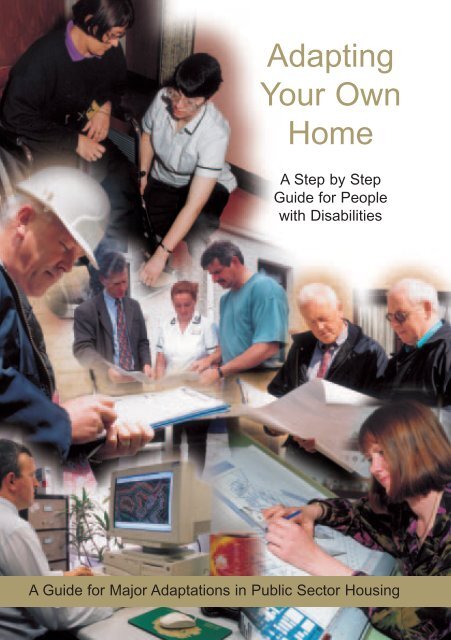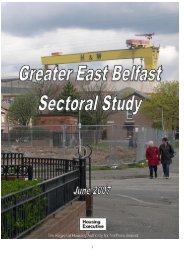Adapting your Own Home - Northern Ireland Housing Executive
Adapting your Own Home - Northern Ireland Housing Executive
Adapting your Own Home - Northern Ireland Housing Executive
Create successful ePaper yourself
Turn your PDF publications into a flip-book with our unique Google optimized e-Paper software.
<strong>Adapting</strong><br />
Your <strong>Own</strong><br />
<strong>Home</strong><br />
A Step by Step<br />
Guide for People<br />
with Disabilities<br />
A Guide for Major Adaptations in Public Sector <strong>Housing</strong>
Contents<br />
Acknowledgements . . . . . . . . . . . . . . . . . . . . . . . . 2<br />
<strong>Adapting</strong> <strong>your</strong> <strong>Home</strong> to Meet <strong>your</strong> Needs . . . . . . . 3<br />
Who is Involved if the Work is Major? . . . . . . . . . . 4<br />
How Long does it Take if I Require<br />
Major Work like an Extension or Lift? . . . . . . . . . . . 6<br />
Heating . . . . . . . . . . . . . . . . . . . . . . . . . . . . . . . . . 8<br />
Getting Started . . . . . . . . . . . . . . . . . . . . . . . . . . . 9<br />
Step 1: The OT Assessment Process . . . . . . . . . 10<br />
Checklist . . . . . . . . . . . . . . . . . . . . . . . . 11<br />
Step 2: Planning, Consultation and Approval . . . 12 <br />
Checklist . . . . . . . . . . . . . . . . . . . . . . . . 14<br />
Step 3: Building Work . . . . . . . . . . . . . . . . . . . . 15<br />
Checklist . . . . . . . . . . . . . . . . . . . . . . . . 16<br />
Your Local Contacts . . . . . . . . . . . . . . . . . . . . . . 17<br />
Glossary of Terms . . . . . . . . . . . . . . . . . . . . . . . . 18<br />
1
Acknowledgements<br />
The DHSSPS and the <strong>Housing</strong> <strong>Executive</strong> would like<br />
to thank the following agencies who made a direct<br />
and valuable contribution to this booklet:<br />
The Community Occupational Therapy Managers<br />
Forum (NI)<br />
Disability Action NI<br />
Eastern Health and Social Services Council<br />
<strong>Northern</strong> Health and Social Services Council<br />
Southern Health and Social Services Council<br />
Western Health and Social Services Council<br />
<strong>Adapting</strong> <strong>your</strong> <strong>Home</strong> to Meet <strong>your</strong> Needs<br />
If you or someone living with you in <strong>your</strong> property<br />
has a disability and you are a <strong>Housing</strong> <strong>Executive</strong><br />
tenant, an adaptation may help you to live more<br />
comfortably in <strong>your</strong> home.<br />
This guide takes you through what will happen when<br />
a major adaptation is carried out to <strong>your</strong> <strong>Housing</strong><br />
<strong>Executive</strong> home. A major adaptation can be the<br />
installation of a stair or through-floor lift, a heating<br />
adaptation or putting on an extension to <strong>your</strong> home.<br />
There are other types of adaptations which are<br />
explained in the Glossary of Terms at the back of<br />
this leaflet.<br />
The <strong>Northern</strong> <strong>Ireland</strong> <strong>Housing</strong> <strong>Executive</strong> and the<br />
Health and Social Services Trusts work in<br />
partnership to help you adapt <strong>your</strong> home.<br />
The process for major adaptations can be confusing<br />
so we have tried to simplify it into 3 main steps and<br />
give general time-scales. There is a checklist at the<br />
end of each section to help you understand what is<br />
happening.<br />
2 3
Who is Involved if the Work is Major?<br />
A number of people may be involved (contact details<br />
are at the back of this leaflet) including:<br />
Occupational Therapists (OTs)<br />
Occupational Therapists (OTs) advise on what is<br />
‘necessary and appropriate’ to meet needs.<br />
They will assist you in choosing an adaptation design<br />
that will help you to be independent or help others to<br />
care for you.<br />
The <strong>Housing</strong> <strong>Executive</strong> Area Welfare Officers<br />
Once the recommendation is received from the OT,<br />
the <strong>Housing</strong> <strong>Executive</strong> Area Welfare Officers will<br />
coordinate everything that needs to be done to<br />
provide major work such as a lift, extension or<br />
heating to <strong>your</strong> home.<br />
Technical Staff<br />
Technical Staff draft sketch plans and final drawings,<br />
seek approvals and provide specialist advice on<br />
technical and practical issues.<br />
This group will include people like architects, building<br />
surveyors and engineers.<br />
Sometimes these people will be <strong>Housing</strong> <strong>Executive</strong><br />
employees but on other occasions they may be<br />
engaged to work on <strong>your</strong> behalf as agents of the<br />
<strong>Housing</strong> <strong>Executive</strong>.<br />
The Contractor or Builder<br />
The Contractor or Builder will be engaged by the<br />
<strong>Housing</strong> <strong>Executive</strong> to complete the work required to<br />
<strong>your</strong> home.<br />
4 5
How Long Does it Take if I Require<br />
Major Work like an Extension or Lift?<br />
Step 1<br />
Occupational Therapy Assessment of Your Needs<br />
The Community Charter states that this Service aims<br />
to initiate <strong>your</strong> assessment within three months.<br />
Your local Health and Social Services Trust will strive<br />
to meet this standard but in practice it can take<br />
longer due to local service demand, the relative<br />
priority of <strong>your</strong> situation and staffing levels.<br />
Step 2<br />
Planning, Consultation and Approval<br />
When the recommendation for adaptation is received<br />
from the Health and Social Services Trust, <strong>Housing</strong><br />
<strong>Executive</strong> staff will look at the options with you,<br />
including whether you would be better to transfer to<br />
another more suitable property. If appropriate the<br />
adaptation is then designed and the necessary<br />
approvals are obtained. On average it will take less<br />
than 4 months to provide a lift and a minimum of 12<br />
months before work will begin on site for an<br />
extension following receipt of the recommendation<br />
from the Health and Social Services Trust.<br />
Step 3<br />
Building/Structural Work<br />
It will take up to 3 days approximately to install a lift<br />
or 3-6 months building work for an extension from<br />
the date the builder goes on site.<br />
Even where everything goes relatively smoothly it<br />
can take approximately a year and a half from<br />
assessment to completion of building work to provide<br />
an extension to the property. In the meantime the<br />
Occupational Therapist may provide equipment or<br />
request minor adaptations to help alleviate difficulties<br />
in the home or Social Services may review <strong>your</strong><br />
home care. Some types of minor work can be done<br />
without Occupational Therapy<br />
assessment relatively<br />
quickly for <strong>Housing</strong><br />
<strong>Executive</strong> tenants. These<br />
are listed in the<br />
Glossary of Terms at<br />
the back of this<br />
leaflet. You<br />
should make<br />
enquiries<br />
directly to <strong>your</strong><br />
District Office<br />
about these.<br />
6 7
Heating<br />
If you cannot manage <strong>your</strong> heating system you<br />
should contact <strong>your</strong> nearest <strong>Housing</strong> <strong>Executive</strong><br />
District Office directly and they will take details which<br />
will then be forwarded to the Area Welfare Officer for<br />
a decision on whether you qualify for heating<br />
improvements.<br />
The Area Welfare Officer’s assessment of heating<br />
should take about 8 weeks and work should start<br />
about 8 months after that although this may vary<br />
according to demand and the availability of funding.<br />
Following assessment <strong>your</strong> Area Welfare Officer will<br />
be able to advise of the likely time you have to wait.<br />
Getting<br />
Started<br />
If you are experiencing difficulty<br />
with everyday activities, (other than<br />
managing <strong>your</strong> heating system) you can request<br />
assessment by an Occupational Therapist from <strong>your</strong><br />
local Health Trust. Up to date medical information<br />
from <strong>your</strong> GP or consultant will help the Occupational<br />
Therapist service to identify <strong>your</strong> needs more rapidly.<br />
8 9
Step 1<br />
The Occupational Therapy<br />
Assessment Process<br />
When a referral is received and accepted, <strong>your</strong><br />
Occupational Therapist will carry out an assessment,<br />
which looks at both <strong>your</strong> needs and where<br />
appropriate <strong>your</strong> carer’s needs, to decide whether<br />
they can be met through a range of services.<br />
The Occupational Therapist will then discuss options<br />
with you. These may include rehabilitation, referral to<br />
other Health and Social Services professionals,<br />
provision of daily living equipment, moving home or<br />
adapting <strong>your</strong> home.<br />
In many instances where needs are less complex it<br />
will be possible to make a recommendation for an<br />
adaptation early on. On some occasions where<br />
needs are complex, more<br />
information may be needed<br />
from other Health and Social<br />
Services personnel to identify<br />
both short and long term<br />
needs. This may involve<br />
contact with people such as<br />
<strong>your</strong> hospital consultant<br />
regarding <strong>your</strong> condition.<br />
The Occupational Therapy service aims to obtain this<br />
information within six months as stated in the<br />
Community Charter.<br />
If adapting <strong>your</strong> home is an option, the Occupational<br />
Therapist will assess the layout of <strong>your</strong> property in<br />
order to help you with <strong>your</strong> daily living requirements<br />
or to enable you to care for the person with a<br />
disability. The Occupational Therapist will also work<br />
with special equipment suppliers where this is a<br />
necessary part of the adaptation.<br />
Step 1 Checklist:<br />
Occupational Therapy Assessment<br />
At the end of this stage the following should have<br />
happened:<br />
1. Agreement with <strong>your</strong> Occupational<br />
Therapist about <strong>your</strong> needs and,<br />
where appropriate, <strong>your</strong> carer’s needs<br />
following assessment . . . . . . . . . . . . .<br />
2. An assessment of <strong>your</strong> home<br />
environment and ideas about options<br />
for adaptation . . . . . . . . . . . . . . . . . . .<br />
3. An Occupational Therapy<br />
recommendation and brief has been<br />
sent to the <strong>Housing</strong> <strong>Executive</strong> Area<br />
Welfare Officer . . . . . . . . . . . . . . . . . .<br />
10 11
Step 2:<br />
Planning, Consultation and Approval<br />
The Area Welfare Officer will receive a recommendation<br />
for adaptation from the Occupational Therapist and<br />
will call with you to discuss the options available to<br />
you. For example if <strong>your</strong> home is very unsuitable or<br />
you live far away from relatives or friends it may make<br />
more sense to move house rather than carry out a<br />
major adaptation. This will be discussed with you.<br />
To help make decisions it may be necessary to<br />
undertake a technical survey to decide whether the<br />
recommended works are technically feasible.<br />
If the decision is made to proceed with the<br />
adaptation, an architect or other technical person will<br />
be asked to draw up sketch plans and these will be<br />
explained to you. The Occupational Therapist will<br />
also see the plans to ensure they meet <strong>your</strong><br />
requirements.<br />
If the work is so extensive that you will not be able to<br />
live at home while the work is in progress, the Area<br />
Welfare Officer will ask District Office staff to<br />
investigate the possibility of finding alternative<br />
temporary accommodation for you.<br />
Following this there will be a time where although you<br />
may not have much contact with <strong>your</strong> Area Welfare<br />
Officer, a lot of work is being done on <strong>your</strong> behalf. This<br />
is the period when sketch plans will be made into<br />
formal working drawings, the cost of the scheme will<br />
be worked out and statutory approvals such as<br />
Planning Permission and Building Control Approval<br />
will be applied for. Once all these details are known,<br />
the final decision for approval of <strong>your</strong> adaptation will<br />
be the responsibility of the Area Manager.<br />
At all times the Area Welfare Officer will help you<br />
understand what is happening and you can contact<br />
them at any point during the process. Sometimes,<br />
however, there are delays which are outside the<br />
control of the <strong>Housing</strong> <strong>Executive</strong>, for example,<br />
obtaining planning permission.<br />
At the end of this stage the <strong>Housing</strong> <strong>Executive</strong> will<br />
appoint a contractor to carry out the work for you.<br />
12<br />
13
Step 2 Checklist:<br />
Planning, Consultation and Approval<br />
At the end of this stage the following should have<br />
happened:<br />
1. Your Area Welfare Officer, <strong>Housing</strong><br />
<strong>Executive</strong> Technical staff and <strong>your</strong><br />
Occupational Therapist have all agreed<br />
with you the best way forward . . . . . . .<br />
2. Formal working drawings and costs<br />
will have been drawn up by the<br />
architect . . . . . . . . . . . . . . . . . . . . . . .<br />
3. Where it is essential, alternative<br />
temporary accommodation will have<br />
been requested for you . . . . . . . . . . .<br />
4. All Planning and Building Control<br />
Approval will have been received . . . .<br />
Step 3: Building Work<br />
Following appointment, the contractor may visit you<br />
to discuss the nature of the work and a start date. As<br />
adaptations are individually tailored to each person’s<br />
needs, each job may be different and involve<br />
different people. The Welfare Officer can explain the<br />
role of these people.<br />
On rare occasions unexpected problems can arise<br />
during construction. If this happens the Area Welfare<br />
Officer, Occupational Therapist and Architect will<br />
have to agree, in consultation with you, the best way<br />
to resolve the problem.<br />
On completion of the work, <strong>Housing</strong> <strong>Executive</strong> staff<br />
will advise the Occupational Therapy department and<br />
where necessary, the Occupational Therapist will<br />
visit to provide equipment such as a shower chair to<br />
help you use <strong>your</strong> new facilities.<br />
5. The Area Manager has approved the<br />
work and a contractor has been<br />
appointed . . . . . . . . . . . . . . . . . . . . . .<br />
14 15
Step 3 Checklist<br />
Building Work<br />
At the end of this stage the following should have<br />
happened:<br />
1. You have a start date for the<br />
contractor to commence work . . . . . .<br />
2. Once work has been completed, the<br />
Occupational Therapist will be<br />
informed . . . . . . . . . . . . . . . . . . . . . .<br />
Your Local Contacts<br />
<strong>Northern</strong> <strong>Ireland</strong> <strong>Housing</strong> <strong>Executive</strong> Area Office<br />
Contact Numbers<br />
Belfast (028) 9031 7000<br />
North East (028) 2565 3399<br />
South (028) 3834 1188<br />
South East (028) 9182 0600<br />
West (028) 7137 2000<br />
(Collon Terrace, Waterloo Place,<br />
Waterside, Limavady District<br />
Offices)<br />
West (028) 8224 6111<br />
(Strabane, Omagh, Magherafelt,<br />
Cookstown District Offices)<br />
Your Local <strong>Northern</strong> <strong>Ireland</strong> <strong>Housing</strong> <strong>Executive</strong><br />
District Office Contact Number<br />
District Office:<br />
Tel:<br />
Health and Social Services Trust<br />
Occupational Therapy Service Contact Number<br />
Address:<br />
Tel:<br />
16 17
Glossary of Terms<br />
Major Adaptation<br />
This would include bedroom or bathroom extension,<br />
heating, vertical lift or stair-lift, major internal<br />
re-arrangement, provision of ground floor toilet.<br />
Minor Adaptations Which Require an<br />
Occupational Therapy Assessment<br />
A number of minor adaptations require assessment<br />
by an Occupational Therapist. Examples would<br />
include a shower, a ramp, graduated steps, grabrails,<br />
etc.<br />
Minor Adaptations Which can be Done Without<br />
an Occupational Therapy Assessment<br />
There is a list of minor work which may be carried<br />
out for public sector tenants directly by the local<br />
<strong>Housing</strong> <strong>Executive</strong> District Office without<br />
recommendation by Occupational Therapist. The list<br />
includes items such as:<br />
• Handrail at front or rear of dwelling or <strong>Housing</strong><br />
<strong>Executive</strong> communal pathways<br />
• Provision of whirly clothes line or path to clothes<br />
line<br />
• Widening of garden paths for wheelchair users or<br />
persons with walking aids<br />
• Defining in curtilage (outside <strong>your</strong> home) steps for<br />
people with visual impairment<br />
• Replacement or re-siting of coal bunkers<br />
• Outdoor lighting for disabled clients with visual or<br />
mobility difficulties<br />
• Paved areas for wheelchairs<br />
• Additional continuous handrail to staircase (or<br />
other parts of dwelling if required)<br />
• Changing door knobs to lever handles as required<br />
• Lowering of Yale Locks<br />
• Re-siting of socket outlets or switches at a<br />
convenient level<br />
• Provision of rocker light switches<br />
18 19
• Provision of adequate internal lighting<br />
• Relocation of clothes hanging rails<br />
• Provision of letter cages or delivery shelves in<br />
entrance hall<br />
• Provision of additional cupboards for storage<br />
• Lowering of cooker mains switch<br />
• Accessible window openings or, if not feasible,<br />
installation of extractor fan with accessible<br />
controls<br />
• Provision of lever taps at wash basin in kitchen or<br />
bathroom<br />
While this booklet outlines many of the steps<br />
involved in a major housing adaptation, it does not<br />
attempt to describe the total process.<br />
Local service providers will offer specific advice<br />
depending on <strong>your</strong> individual circumstances.<br />
Please note that lists of adaptation types contained<br />
in this document are given as examples only and are<br />
not intended to be definitive lists of what is available.<br />
Calls are welcomed via BT Text Direct for<br />
text or minicom users. Insert 18001 in front<br />
of the number you wish to dial.<br />
This information can also be made available<br />
in alternative formats. Contact:<br />
Maurice Rooney<br />
Principal Officer<br />
<strong>Housing</strong> and Regeneration<br />
<strong>Northern</strong> <strong>Ireland</strong> <strong>Housing</strong> <strong>Executive</strong><br />
The <strong>Housing</strong> Centre<br />
2 Adelaide Street<br />
Belfast BT2 8PB<br />
Tel: (028) 9024 0588<br />
Translation services are available via a<br />
telephone service called Language Line in<br />
each <strong>Housing</strong> <strong>Executive</strong> office.<br />
20<br />
21
Notes<br />
Notes<br />
22 23
24<br />
Notes
December 2002<br />
www.nihe.gov.uk

















